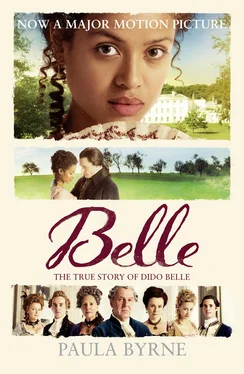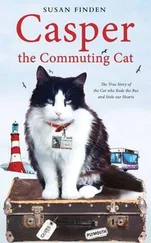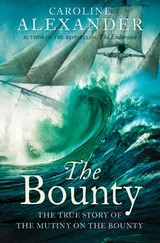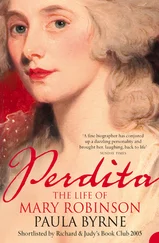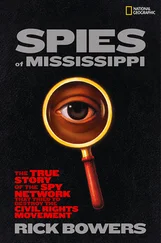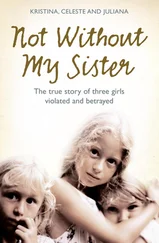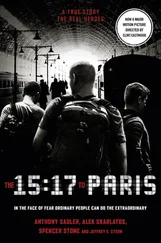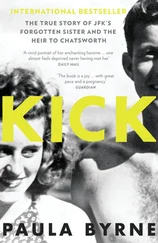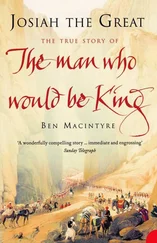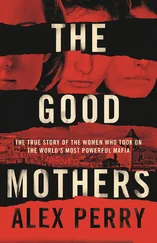Almost equal , because the white girl occupies the foreground of the painting. But the viewer is left with little doubt that it is the black girl who has captured the imagination of the artist. She is dressed in an exotic style, bearing colours that give the painter the opportunity to show off the full range of his palette. The dress, though as expensive and beautiful as the white girl’s, signals her difference. The sheer shawl looks Indian, as do the turban and feather. Intriguingly, a tartan or plaid shawl is tied around her waist. Could she have Scottish heritage?
The white girl is made to look demure – the wreath of rosebuds in her hair suggests virginity – while her black companion sports one of the most fashionable accessories of the day: an ostrich feather, as popularised by the leading fashion icon of the era, Georgiana, Duchess of Devonshire. Georgiana created her first great stir in 1775, when the British Ambassador in Paris, Lord Stormont, presented her with a four-foot-long ostrich feather, which she contrived to incorporate within a spectacular hairdo. From then on, every fashionable lady wanted an ostrich feather – to the extent that the poor bird was hunted almost to extinction in North Africa. Lord Stormont was the father of the white girl in the picture.
The language of painting in the eighteenth century was heavily symbolic. The basket of exotic produce points to the black girl’s foreign background, with the ripe fruits – grapes and figs and peaches – suggesting her lusciousness. At a literal level, she is carrying fruit that she has picked in the orangery or the hothouse for the dinner table of the big house. But at a metaphoric level she is herself being compared to a sweet foreign fruit flourishing on English soil (a wealthy man with an orangery or glasshouse could grow his own pomegranates and pineapples, but even a middle-ranking householder who was prepared to pay could go to Covent Garden market and buy exotic produce that had been cultivated in the Tarring Fig Gardens of Sussex). The grapes are a mix of black and white, happily entwined in what could be an allusion to some close bond between the girls. Though so physically different, could they share some of the same blood?
We will never know whether the black girl was happy to be dressed this way and to pose as she does. Nor will we know what inspired her pose. The idea seems to be that she is hurrying to the house with the basket of fresh fruit. As she brushes against the green bench on which the white girl sits reading, the latter reaches out a hand and takes her arm. Is she stopping her so as to give an instruction, or to have a sisterly chat? Was it the girls’ idea, or the painter’s, or the commissioner’s, to represent their relationship by means of this encounter? Wherever the conception came from, it is a brilliant evocation of an ambiguous relationship. On the one hand, the white girl is a member of the leisured classes (she sits, she reads, she does not have to work), while the black girl is a servant (she must pick the fruit, take it into the house and then hurry on to her next job). On the other hand, the two girls are companions, at ease in each other’s company and equal in their finery. It seems unlikely that an ordinary servant girl, of whatever skin colour, would wear such clothes when picking fruit.
The dark-skinned girl’s eyes are shiny and expressive. Whatever she was really feeling, the painter has made her look happy. There is a playfulness to her expression that the white girl lacks. Her hair is sleek, not curly, tamed beneath the turban. The silk of her dress clings to her lower body as she moves. The trace of her thigh seen under the fabric is highly erotic in an age when even the outline of women’s legs was rarely seen in public (except on the stage, when actresses were crossed-dressed in ‘breeches’ parts). If you look closely, you can see that the girl’s left hand rests between her thighs in a provocative gesture, offering a whiff of Georgian England’s stereotyping of black women as sexual creatures.
By contrast, the white girl’s stiff hoops and petticoats conceal her body. The tight bodice imprisons her. The extra layer of gauze over her full skirt gives a strange, cage-like effect. Her open book suggests that she is fond of reading. It might be a commonplace book with choice extracts pasted into it, or a conduct book, a work of religious piety or a collection of sermons, though one would like to imagine that it is a volume of poetry or a play, or even an example of that very daring and new genre of literature, the novel. The eighteenth century was the first great age of female reading. Young women devoured Samuel Richardson’s best-seller Pamela , with its daring depiction of a young servant girl who resists her master’s sexual advances and eventually becomes his wife. Not to mention his tragedy of Clarissa , who is raped by her aristocratic lover and dies. Or Fanny Burney’s Cecilia , a troubled novel about a wealthy young girl who is badly exploited by her male guardians and temporarily goes mad. The latter part of the eighteenth century witnessed a flourishing of heroine-centred novels that explored female consciousness and identity. Questions of marriage and money, propriety and property, were constant themes. Some of the fictional heroines were low-born, lacking in wealth and status and connections; but all were white. It would take a little while longer for a pioneering novelist to depict a mixed-heritage girl, a ‘mulatto’: that is what Jane Austen did during the Regency years in her final, unfinished novel, Sanditon .
The white girl’s open book is a hint of her education and gentility. Few women in the eighteenth century went to school, but well-born girls were educated at home. A good library was an essential room in a gentleman’s country house: the book perhaps also serves to flatter the commissioner of the painting by implying that he has a particularly well-stocked collection.
The sitting girl holds her book in one hand, but our attention is drawn more to the other hand, the one that is stretched out: a white hand gripping the black arm of her companion. In the age of slavery-abolitionist fervour, the motto ‘Am I not a sister and a friend’ was often emblazoned on ladies’ pincushions and hair ornaments. Some modern spectators might feel that the black girl’s ‘ethnic’ costume, her basket of fruit and her sexually charged demeanour are degrading. But the hand gesture suggests affection and equality between the girls. For all the ambiguity of the image, the standing girl is ultimately represented as sister, cousin or friend, not as a servant, slave or inferior being. She is drawn into the picture as a cherished member of the family.
Portraits tell stories, and this one tells a story of love and sisterhood, unity between black and white, illegitimacy and gentility, vitality and virtue. A story, furthermore, that brings us to the very heart of a larger historical story: the abolition of the slave trade.
In the course of the last two and a bit centuries, this double portrait has moved between Kenwood House on the northern boundary of Hampstead Heath in London, where it was painted, and Scone Palace just outside Perth in Scotland. Kenwood House was, and Scone Palace is, the seat of the Earls of Mansfield. The portrait was commissioned some time in the late 1770s or early 1780s by William Murray, the first Lord Mansfield, Lord Chief Justice and the most admired judge in eighteenth-century Britain. His name was by this time irrevocably linked with the question of slavery and abolition, as a result of his judgement in a famous case of 1772.
But these are not Lord Mansfield’s daughters. He and his wife Elizabeth ( née Finch) were childless. The girl in the foreground of the picture is Lady Elizabeth Murray, his great-niece, who was brought up at Kenwood following the death of her own mother when she was a young child. For much of the twentieth century, the Mansfield descendants believed that the other girl was some kind of household servant. In an inventory of Kenwood taken in 1904, the portrait was described as ‘Lady Elizabeth Finch-Hatton with a Negress Attendant’, and attributed to the great society artist Johann Zoffany. 1There was a tradition of portraits of masters or mistresses with a servant or slave in the background. It was assumed that this was a variation on the theme, though with unusual prominence given to the servant. The family did not stop to consider the irony of Lord Mansfield, forever seen as a key figure in the abolition of slavery, commissioning a portrait that might seem to imply that he kept a slave himself. The painting remained little-known.
Читать дальше
